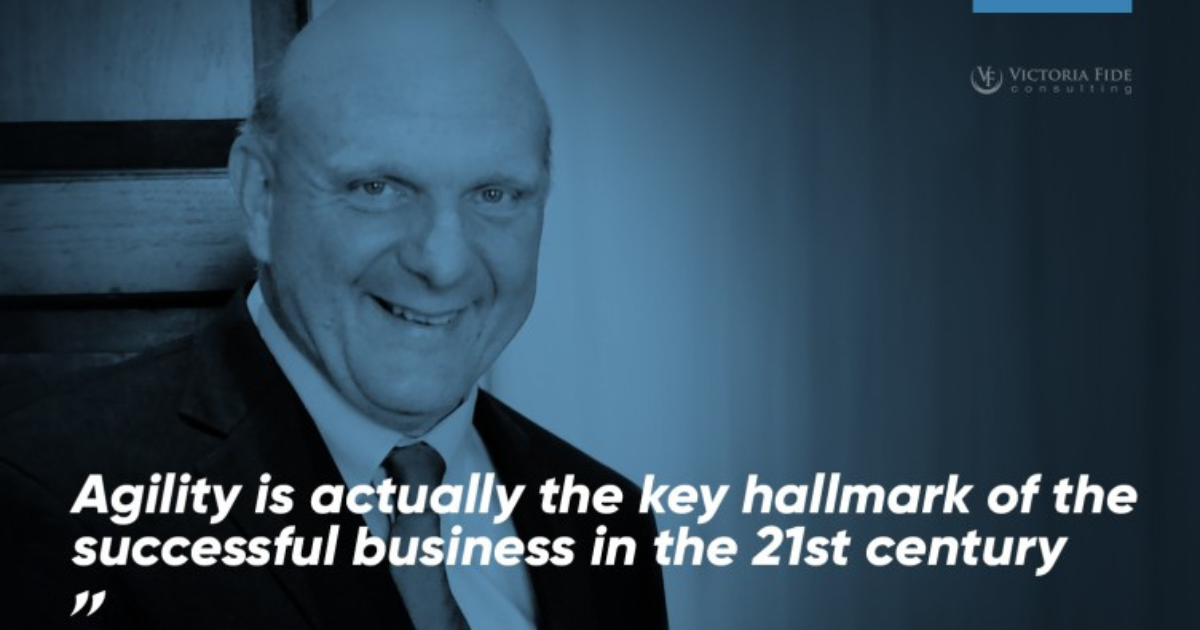
The Sage Wisdom series is produced by Victoria Fide Marketing with input and oversight from our leadership team and industry SMEs.
Steve Ballmer, the former CEO of Microsoft, is best known for his remarkable tenure at the helm of one of the world’s leading technology giants. Serving as CEO from 2000 to 2014, Ballmer oversaw a pivotal period in Microsoft’s history. Under his leadership, Microsoft aggressively pursued the enterprise market with products like Office 365 and Azure. While his tenure was marked by both successes and challenges, Ballmer’s legacy in the tech industry remains closely tied to his role in navigating Microsoft through a transformative era.
His statement, “Agility is the key hallmark of a successful business in the 21st century,” is aligned with the concept of organizational maturity, which is the ability of an organization to adapt to change. In today’s ever-evolving business world, the emerging significance of adaptability and flexibility demands a high level of organizational maturity for organizations to thrive.
However, companies often struggle to assess their organization’s maturity due to a lack of standardized benchmarks for measuring maturity consistently across various industries and functions. In addition, internal biases can cloud the perception of an organization’s maturity, leading to overestimation or underestimation of capabilities. This article will provide a framework for assessing your current level of organizational maturity. Furthermore, it will present strategies for achieving a higher level, thereby increasing the odds of a successful digital transformation.
Understanding Agility in the 21st Century
In the 21st century, technology is moving faster than ever. Every year new phones, apps, and gadgets are released to the public. Businesses also face this rapid change in technology with the rise of AI, machine learning, blockchain technology, and the Industrial Internet of Things (IIoT) to name a few. They must stay flexible in the face of such change, or risk falling behind their competitors.
Along with the rapid progression of technology, the consumer landscape is constantly shifting. More and more people are shopping online, choosing organizations whose values align with theirs, and being influenced by trends and cultural movements from social media. Adapting to these shifts is a new requirement for companies to succeed in this age. Today, it’s simply not enough to sell a great product; businesses must be able to deliver an exceptional customer experience.
In today’s globalized business landscape, access to opportunities across international markets is more accessible than ever before. Preparedness is the key to seizing these often fleeting opportunities. That means businesses must foster adaptability and embrace an iterative cycle of organizational maturity.
The Importance of Organizational Maturity
Organizational maturity is the ability of an organization to adapt to change. Think of it like a boat sailing through ever-changing seas, representing the ever-changing business landscape. A company with low organizational maturity resembles a traditional sailboat relying on wind power to navigate the tides of change and adversity. These organizations are limited in their ability to successfully implement the transformational changes they seek.
Conversely, an enterprise with a high level of organizational maturity is like the Gerald R. Ford, the most advanced aircraft carrier in the US navy. Ford-class ships have been meticulously designed to enhance lethality, survivability, and joint interoperability while requiring a 20% smaller crew compared to a Nimitz-class carrier. Similarly, mature organizations can respond to the changing winds and ride the industry-disrupting waves.
It is important to note that the level of maturity required is proportional to the level of transformation being attempted. Just as knowing what vessels are available can help you embark on an appropriate voyage, assessing your organization’s level of maturity can help you determine if you are prepared to undertake a digital transformation initiative. In the business context, these assessments encompass factors such as well-defined processes, a clear strategy, trust in leadership, and an experienced crew. When these elements are in place, it signifies that an organization has reached maturity, ready to tackle the dynamic challenges of the business world—much like a seaworthy vessel prepared for any sea conditions.
The 5 Levels of Organizational Maturity
The journey to organizational maturity is marked by five distinct levels, each reflecting the organization’s ability to navigate change and challenges effectively. These levels, used by the KPI institute, provide a framework for understanding how mature an organization is in its approach to processes, strategies, and adaptability.
Understanding these five levels of organizational maturity can help businesses assess their current position and chart a path for growth and improvement in the ever-changing business landscape. Let’s explore each level and its defining characteristics:
1. Initial Level – The Initial level is characterized by experimentation and a lack of stability.
- Ad hoc: At this stage, processes and procedures are ad hoc, often unplanned or reactive.
- Chaotic: There’s a sense of chaos as the organization lacks clear structures and guidelines.
- Initial: The organization is in its infancy, just starting to explore its capabilities.
- Inconsistent: Actions and decisions are inconsistent, leading to unpredictable outcomes.
Take control of your project’s success today and schedule a free 30-minute consultation with Tory Bjorklund, the founder and CEO of Victoria Fide. With our expertise, we can rescue your ERP implementation, saving you valuable time and money. Find the answers you seek by taking this crucial step toward a successful ERP implementation.

2. Emergent Level – An organization at this level signals its intent to become a more robust entity.
- Emerging: The organization begins to emerge from chaos, with some structure taking shape.
- Managed: Processes are managed, and there’s a sense of control.
- Standardized: Basic standards and procedures are introduced.
- Repeatable: Actions become more repeatable, leading to some level of predictability.
3. Structured Level – The Structured level represents a more mature phase where the organization has established clear guidelines and practices.
- Defined: Processes and procedures are clearly defined and documented.
- Measured: There’s a focus on measurement and analysis of performance.
- Structured: The organization operates with structured guidelines and practices.
- Competent: Teams and individuals demonstrate competence in their roles.
4. Integrated Level – At the Integrated level, the organization is aligned with its surroundings.
- Aligned: The organization’s processes are aligned with its strategic goals.
- Predictable: There’s a high degree of predictability in outcomes.
- Disciplined: The organization operates with discipline and adherence to standards.
- Metrics: Metrics and key performance indicators (KPIs) play a crucial role in decision-making.
5. Optimized Level – Organizations at this level gave reached pinnacle of maturity, enabling them to thrive through adversity and continuously reaching for new heights.
- Adaptive: The organization is highly adaptive, swiftly responding to change.
- Opportunistic: It identifies and seizes opportunities in a proactive manner.
- Proactive: The organization takes a proactive approach to problem-solving.
- Continuous Improvement: A culture of continuous improvement prevails, driving innovation and growth.
To achieve an accurate assessment of organizational maturity, it is prudent to gain an external perspective. Hiring an outside consultant to assess your organizational maturity will prevent internal biases and produce a more accurate assessment. Depending on the type of assessment, you may also receive recommendations and an action plan that will help you improve your overall organizational maturity.
Strategies for Improving Organizational Maturity
Leaders play a crucial role in promoting agility within your organization. They set the tone and direction, influencing how well your company adapts to change. Effective leaders encourage open communication, inspire innovation, and create an environment where employees feel empowered to make decisions. By fostering a culture of adaptability and agility, leaders help the organization respond swiftly to evolving circumstances.
Creating a culture of continuous improvement is vital for enhancing organizational maturity and, consequently, agility. In this culture, change is not seen as a disruption but as an opportunity for growth. Encourage your teams to engage with external experts, regularly review processes, identify areas for enhancement, and implement changes based on feedback and data. Embrace a mindset of learning from both successes and setbacks. By fostering a culture that values change and learning, your organization becomes better equipped to navigate the ever-evolving business landscape.
Agility and Organizational Maturity: Key Takeaways
Steve Ballmer’s quote demonstrates that agility—the ability to adapt and respond swiftly—is a key requirement for businesses to succeed in today’s dynamic landscape. In order to have the necessary agility and adaptability, organizations must achieve a high level of organizational maturity.
Investing in an external consultant to assess your organization will provide you with a more accurate, objective perspective. You can then use that information to build an action plan and roadmap for improving your organizational maturity and thus improving your odds of digital transformation success. Focus your attention on building a strong leadership foundation and a culture of continuous improvement to equip your team for the agility this digital age requires. By preparing your people for change, your organization will become more resilient and agile, able to navigate the ever-changing business landscape and achieve sustained success.

Subscribe to our weekly LinkedIn Digital Transformation Success newsletter and get notified of each new edition.
